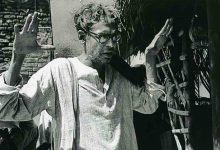Few would know that once upon a time Lucknow also featured on the map of India as a centre of film production.
Cinema came to Lucknow via Calcutta. The railway line of the East India Railways (EIR) traversed from Howrah, to Allahabad, to Agra and ended at Ambala. On this route there was much traffic of Englishmen moving into Punjab, of Bengali lower middle class moving into Punjab seeking jobs and the rich Bengali bhadralok venturing into Oudh for holidays and trade.
Lucknow was the centre for most of the Zamindaars (land owning gentry) whose wards were being sent abroad for higher education. The presence of the cantonment also suggested the presence of an army contingent . Lucknow had prosperity, youth and culture. Therefore when some people started constructing new cinema halls, there were others who dreamt of making films, and so this had to happen.
The wherewithal for film production came from the Bengali film makers who were scouting for funds for making new films. It was the time when silent films were being made and there was no language barriers. These silent films could be taken to any part of the world and shown on rent or sold outright.
Around 1922, some young scions of the landowning class decided to create a film cooperative to produce films. The production group was registered as Zamindara Film Company . This film company made two films and then closed down business.
In 1927, another set of businessmen created a new company for producing films and established a film production centre on modern lines. This was called the Kailash Studio which was located on a big plot of land opposite the Burlington Hotel in Hussainganj. Kailash Studio ran its business for nearly nine years and made five films. The later famed music composer, Naushad Ali, was also employed here briefly as an assistant table player for the Studio orchestra before he moved to the local All India Radio and finally moved to Bombay to join the crowd of youth seeking a career in the film business.
The closure of Kailash Studio sometime in 1934 finally also put an end to Lucknow being associated with film production. But film exhibition business flourished. From early 1950s Lucknow began to offer artists to the Hindi film industry starting with Naushad Ali, Pushpa Hans, Bina Rai, Sunil Dutt (he lived in Aminabad) Jaan Nisar Akhtar, Muzaffar Ali, Sudhir Misra, and Anupam Kher who worked in Bhartendu Academy for a couple of years.
It was Dilip Kumar who felt that Uttar Pradesh should have a film production centre and he applied for a piece of agricultural land in 1961, to develop a film studio. The State government allotted a piece of land in Mohan Nagar area but Dilip Kumar could not develop this idea and returned the land to the government. Sunil Dutt and Nargis followed the same route and then gave up the idea. All felt this business could not be run sitting in Bombay. Again in 1976, when Narain Dutt Tiwari was the CM, a scheme to bring industries into UP was conceived and NOIDA was planned. A full sector was earmarked for allotting plots to film and television operators. Some Bombay film producers were asked to buy some plots and start offering studio facilities. While film production did not take off, but when television activity came into being in 1983 after the Asian Games, NOIDA sprang into big activity in film crafts.
It was Muzaffar Ali when he started his film Gaman (1979) and Aagaman that UP began to be talked of as a possible place to shoot outdoor scenes of rural countryside. A major portion of the Shyam Benegal film Junoon (1979) was shot in Malihabad in the suburb of Lucknow. Ismail Merchant made his film Shakespearewala partly in Lucknow. Film Ghadar was also filmed in Lucknow.
Besides Lucknow, the other town which began to see visits of film crews from parts of India and even abroad, was Agra. Ismail Merchant again shot a portion of his colour film Guru in Varanasi.
Uttar Pradesh got special attention finally when Mulayam Singh became the Chief Minister for the first time with his political friend Amar Singh in tow.
Amar Singh had friends in Mumbai who wanted a new friendly film policy to be created in UP. This film policy was announced in the year 1999 which provided for big subsidy as incentives to film makers when they made films in UP and in Hindi. A series of small budget films are made and the promise of film subsidies was kept. This encouraged the bigger film producers to also move in. Today Uttar Pradesh is the back ground for over fifty film titles under production and another three dozen projects are in various stages of approval. UP which was once considered too dangerous a place for film folks to visit for promotional appearances or film shooting, is now bristling with film activity. A Rekha may still create a public stampede, but lesser artists can freely face the camera unmindful of interference by onlookers, who now appreciate the value of “silence” call from the film director at work.
All this has led to some reduction in pressure of work in the indoor studies in Mumbai. But Uttar Pradesh is now threatening to provide more incentives of hassle free studio facilities and strike free environment to film production companies.
The situation in Mumbai for film makers is riddled with artist labour union directives which make it expensive for any film startup to meet the demands. The Shiv Sena managed unions behave in a dictatorial manner, threatening closure of film project if they did not approve of the nationality of the artist. UP has no hiccups on this issue.
With the development of a new language cinema in Bhojpuri language, Varanasi has now emerged as a regular film shooting centre alternate to Mumbai and its neighbourhood. And with the return of Haryanavi language cinema, Meerut region is again a thriving film business centre which is seeing a regular film cassette business running at least into Rs 100 crore. An occasional film production team can also be seen making films in the local language. As for Lucknow, its air connectivity directly by air and rail and the development of good hotels for the stay of lesser stars, has helped big film production companies to anchor themselves in Lucknow and complete their projects at half the cost if the same were done in Mumbai.
How attractive has Uttar Pradesh become for film producers? A film producer who shots his film in UP can now see a subsidy offer upto Rs 2 crore which for a small film company be half the production cost. He gets an incentive of Rs 25 lakhs if the film employs five local artists, another Rs 50 lakhs if all the artists are from the State. This could mean that an astute film maker can get the State of UP fund upto 70 percent of the film production cost. Cities like Kanpur, Lucknow, Dehra Doon(Uttrakhand), Allahabad, Varanasi, Aligarh can offer fairly good class of acting talent to film companies and NOIDA has package deals in post production work. Mumbai can be given a farewell to visit for business if it comes to the crunch.
But there is a track two story of cinema in Uttar Pradesh. This is the work done by the government away from the film world of Bombay.
Beginning from 1947, as soon as the country attained its independence, the govt of United Provinces established its Department of Information. It also employed one Laxmi Kant Shukla, a former production manager from Bombay Talkies Production studios of Bombay to revamp the department. The UP dept of Information in the 1950s had two ‘star’ employees, Suresh Nigam and Sarla Sahni.
Nigam had joined the State department after doing a stint in the film studios of Bombay. As for Sarla Sahni, she had been briefly a protégée of the famous documentary film maker from Germany Leni Riefenstahl when the German lady was held back in France facing charges of Nazi collaboration during 1948-55.
Sarla Sahni took some of feisty dust from her German guru and was well known in the UP official circles as the ‘pants- officer’. It was Sarla Shni who pulled the first film crews from Bombay to come and use the countryside for their productions.
It was in her time that the Uttar Pradesh Film Development Corporation was established to promote films made in UP by film producers and also to show them on cinema theatres run by this Corporation. Unfortunately this experiment failed miserably because no one had learnt in the government how the film trade operated. There were also many cases of fund embezzlements. In 2000 the ‘Film Bandhu’ office was opened to implement the new State film policy.
Till date this State level corporation has supported over fifty film productions and is considered a success story in the context of UP government ‘culture’. Film production companies are no more afraid to come to Lucknow and Varanasi to make films which have a mix of small town and rural backgrounds. Successful films like Bareilly Ki Barfi, Toilet:Ek Prem Katha, Bahen Hogi Teri, Mukti Bhavan, Masaan, Bunty Aur Bubly, Tannu Weds Manu, Dedh Ishquiyaa, Jolly LLB, Raid, Youngistaan, are some examples of films which were made in several parts of the State. There are at least another 36 titles awaiting scrutiny because they involve State subsidies.
Lucknow in the past was identified by Oudh culture of good tehzeeb (manners) as seen in films like Mere Mehboob, Chaudhveen Ka Chand, Ghazal, Gomti Ke Kinare, Benazir, Shatranj Ke Khilari, Junoon, Umrao Jan, Umrao Jan Ada and more. The old time faded away as the culture regressed into the old bricks of the city. Modern Lucknow took its place, and has not lost any of its glint.





